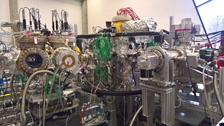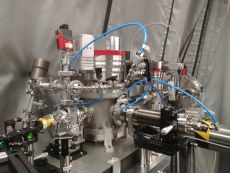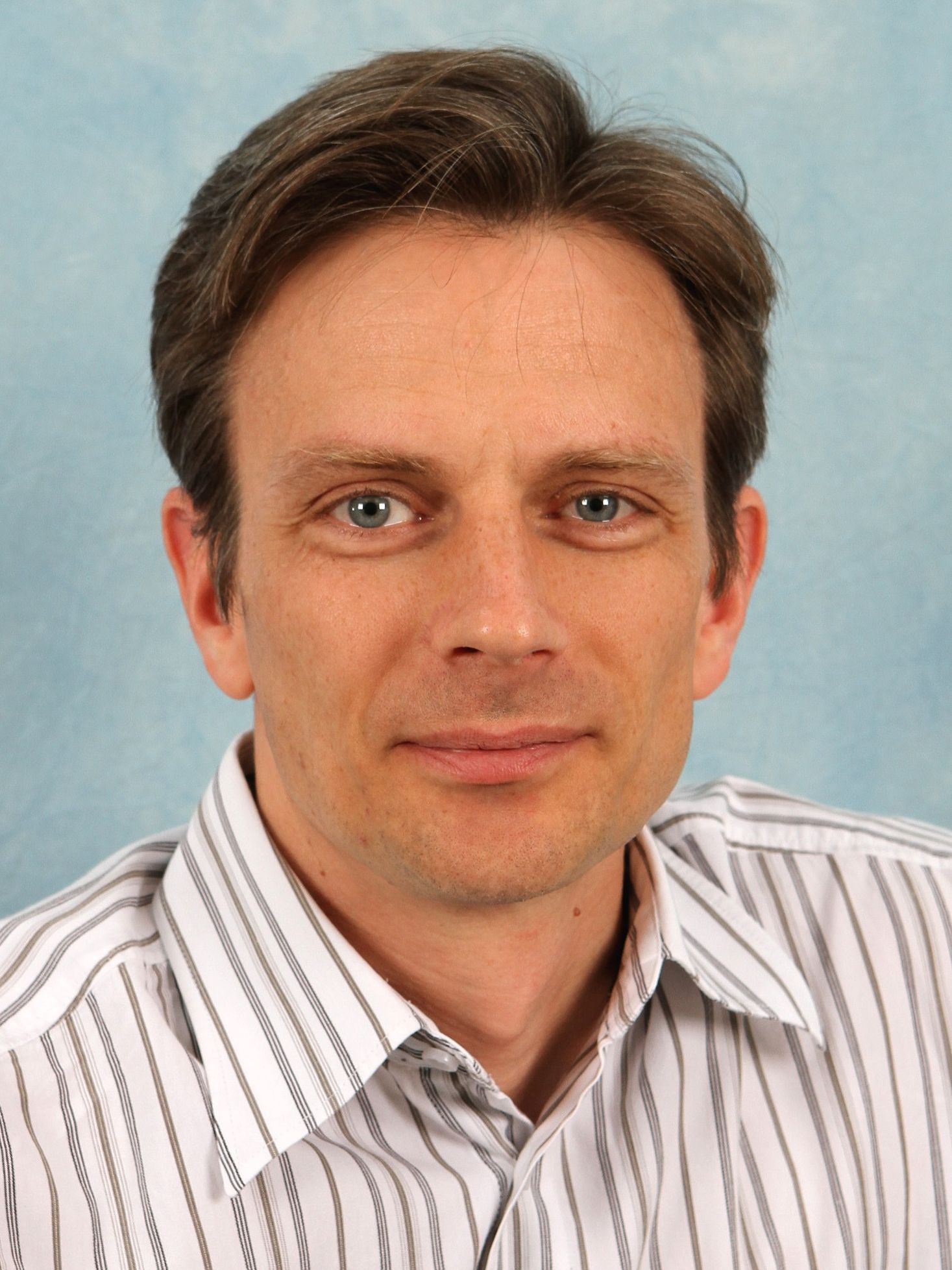Picture of the REMI instrument together will the in-line split&delay and focussing mirror chamber installed at FL26 in the FLASH2 experimental hall ‘Kai Siegbahn’.
At FL26 a reaction microscope (REMI) is installed as a permanent endstation [1,2]. The REMI has initially been built as a mobile device by Robert Moshammer’s group from the MPIK in Heidelberg (MPIK) and contributed significantly to the field of AMO science at FLASH since the very beginning. Based on a workshop in 2012, there was a decision to have the REMI permanently installed, in a collaboration of MPIK and the FLASH team, at a dedicated beamline of FLASH2 in order to further improve the efficiency of the scientific work with such a powerful as well as complex instrument. With the reaction microscope all fragments of a photoionization process can be detected by means of a combination of electron and ion time-of-flight spectrometers and a specific arrangement of electric and magnetic extraction fields [3]. Using a coincident measurement technique, a complete set of all kinematic properties of the products of the photoionization process can be determined. Hence, this device is especially suited to investigate the the dynamics of various ionization processes of gas phase and liquid targets.
At FL26 the FLASH2 XUV pulses are focused into the REMI interaction region by an ellipsoidal mirror to a measured focal spot size of 4x5 microns (FWHM). The 30 nm carbon mirror coating is suitable for photon energies of up to 160 eV (7.8 nm) and the reflectivity is larger than 75% in the wavelength range between 9 and 41 nm. Details of the available FLASH2 XUV pulse parameters: FLASH Parameters.
The setup offers unique options for multi-color time resolved experiments using wavelengths from the near infrared to the XUV:
- The beamline is equipped with an XUV split&delay mirror to enable XUV-pump/XUV-probe experiments for photon energies up to 160 eV [1]. The split and delay unit offers a time delay in a range of ±2.7 ps.
- The fully synchronized FLASH2 NIR laser can be focused into the REMI interaction region (FLASH Optical Laser Systems).
- A fully synchronized HHG laser source has been developed within an ErUM-Pro collaborative research project (FKZ 05K16MH1) lead by U. Morgner and M. Kovacev from the Leibniz Universität Hannover in collaboration with DESY and MPIK. It offers ultrashort VUV pulses with wavelengths between ~35 nm and 124 nm [4,5].
|
|
|
|
Pump-Probe Lasers and Endstation Instruments
You can find the parameters of our Pump-Probe Lasers serving the individual beamlines HERE.
You might also want to have a look at our portfolio of instruments HERE in order to find out what is most suitable for your experimental idea.
References:
[1] G. Schmid et al., Reaction microscope endstation at FLASH 2, J. Synchrotron Rad. 26, 854-867 (2019); https://doi.org/10.1107/S1600577519002236
[2] S. Meister et al.,Atomic, Molecular and Cluster Science with the Reaction Microscope Endstation at FLASH2, Appl. Sci. 10, 2953 (2020); https://doi.org/10.3390/app10082953
[3] J. Ullrich et al., Recoil-ion and electron momentum spectroscopy: reaction-microscopes, Rep. Prog. Phys. 66, pp. 1463–1545, (2003); https://dx.doi.org/10.1088/0034-4885/66/9/203
[4] E. Appi et al., Synchronized beamline at FLASH2 based on high-order harmonic generation for two-color dynamics studies, Rev. Sci. Instr. 92, 123004 (2021); https://doi.org/10.1063/5.0063225
[5] E. Appi et al., A synchronized VUV light source based on high-order harmonic generation at FLASH, Scientific Reports 10, 6867 (2020); https://doi.org/10.1038/s41598-020-63019-2
REMI and other Publications from FL26: click here
Former REMI Publications from FLASH1:
- Georg Schmid et al., Tracing Charge Transfer in Argon Dimers by XUV-Pump IR-Probe Experiments at FLASH, J. Chem. Phys. 151, 084314 (2019).
- G. Schmid et al., Terahertz-Field-Induced Time Shifts in Atomic Photoemission,Phys. Rev. Lett. 122, 073001 (2019).
- S. Augustin et al., Signatures of autoionization in the angular electron distribution in two-photon double ionization of Ar, Phys. Rev. A 98, 033408 (2018).
- K. Schnorr et al., Time-resolved study of ICD in Ne dimers using FEL radiation, J. Electron Spectrosc. Relat. Phenom. 204, 245-256 (2015).
- K. Schnorr et al., Electron Rearrangement Dynamics in Dissociating I2n+ Molecules Accessed by Extreme Ultraviolet Pump-Probe Experiments, Phys. Rev. Lett. 113, 073001 (2014).
- K. Schnorr et al., Multiple ionization and fragmentation dynamics of molecular Iodine studied in IR XUV pump-probe experiments, Faraday Discuss. 171, 41-56 (2014).
- Y.H. Yiang et al., Ultrafast dynamics in acetylene clocked in a femtosecond XUV stopwatch, J. Phys. B 46, 164027 (2013).
- R. Moshammer et al., Moleküle im Blitzlicht des Freie-Elektronen-Lasers FLASH – Chemische Reaktionen in Superzeitlupe, Physik in unserer Zeit 44, 20-27 (2013).
- K. Schnorr et al., Time-Resolved Measurement of Interatomic Coulombic Decay in Ne2, Phys. Rev. Lett. 111, 093402 (2013).
- M. Magrakvelidze et al., Tracing nuclear-wave-packet dynamics in singly and doubly charged states of N2 and O2 with XUV-pump-XUV-probe experiments, Phys. Rev. A 86, 013475 (2012).
- J. Ullrich et al., Free-Electron Lasers: New Avenues in Molecular Physics and Photochemistry, Annu. Rev. Phys. Chem. 63, 635-660 (2012).
- Y.H. Jiang et al., Ultrafast Extreme Ultraviolet Induced Isomerization of Acetylene Cations, Phys. Rev. Lett. 105, 263002 (2010).
- Y.H. Jiang et al., Temporal coherence effects in multiple ionization of N2 via XUV pump-probe autocorrelation, Phys. Rev. A 82, 041403(R) (2010).
- A. Rudenko et al., Exploring few-photon, few-electron reactions at FLASH: from ion yield and momentum measurements to time-resolved and kinematically complete experiments, J. Phys. B 43, 194004 (2010).
- M. Kurka et al., Differential cross sections for non-sequential double ionization of He by 52 eV photons from FLASH, New J. Phys. 12, 073035 (2010).
- Y.H. Jiang et al., Investigating two-photon double ionization of D2 by XUV-Pump-XUV-Probe experiments, Phys. Rev. A 81, 051402(R) (2010).
- Y.H. Jiang et al., Tracing direct and sequential two-photon double ionization of D2 in femtosecond extreme-ultraviolet laser pulses, Phys. Rev. A 81, 021401 (R) (2010).
- M. Kurka et al., Two-photon double ionization of Ne by free-electron laser radiation: a kinematically complete experiment, J. Phys. B: At. Mol. Opt. Phys. 42, 141002 (2009).
- Y.H. Jiang et al., EUV-photon-induced multiple ionization and fragmentation dynamics: from atoms to molecules, J. Phys. B 42, 134012 (2009).
- Y.H. Jiang et al., Few-Photon Multiple Ionization of N2 by Extreme Ultraviolet Free-Electron Laser Radiation, Phys. Rev. Lett. 102, 123002 (2009).
- A. Rudenko et al., Recoil-Ion Momentum Distributions for Two-Photon Double Ionization of He and Ne by 44 eV Free-Electron Laser Radiation, Phys. Rev. Lett. 101, 073003 (2008).
- R. Moshammer et al., Few-photon Multiple Ionization of Ne and Ar by Strong Free-Electron-Laser Pulses, Phys. Rev. Lett. 98, 203001 (2007).











